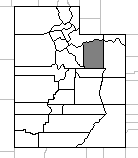
A UTGenWeb & USGenWeb Project
History
On-Site Resources
Last Updated: November 2020
The First Residents
Prehistoric rock art and architecture such as those seen at Nine Mile
Canyon were left behind by the natives of the Fremont Indians can still
be seen in many places within Duchesne County and the Uinta Basin.
Occupation by the Fremont Culture began (roughly) from A.D. 300. For
unknown reasons, the Fremont peoples began to disapear around 1200. They
were succeeded by the Numic speakers who arrived around 1300 who became
the ancestors of the Shoshoni and Ute people. Although these these later
tribes had dealings with the Spanish, they were for the most part left
undisturbed until the arrival of the LDS pioneers into Utah which also
began a steady stream of white immigrants. A early Utah Indian agent,
Jacob Forney estimated that there were 1,000 Utes living within the
Uinta Basin.
In 1861, President Lincoln issued an executive order establishing the
new Uintah Valley Indian Reservation and the Utes were forced to move to
this reservation over the next few years. The first Uinta Indian Agency
was located at the head of Daniel's Canyon. This proved to be a poor
choice due to the harsh winters experienced in the area and the agency
was then moved to the upper Duchesne River near Hanna. The agency was
moved in 1867 to an area north of present-day Starvation, and again by
Agent Pardon Dodds to Whiterocks in Uintah County. Other early Indian
agents were Thomas Carter, L.B. Kenney, O.H. Irish, F.H. Head and J.J.
Critchlow (who counted 800 Utes living on the reservation in the winter
of 1872-73.
In 1881 The Uintah Utes were joined by the White River and Uncompahgre
Utes who were moved from Colorado and are now known as the Northern
Utes. The government then decided another Indian agency was needed and
in 1886 Fort Duchesne (Uintah County) was established. The fort was run
by two companies of black calvary known to the Utes as "Buffalo
Soldiers" *
With the Dawes Act, the Indian reservation was open to homesteaders.
Native Americans were given allotments of land on which to make their
homes. By August 1905 white settlers were arriving to claim their 160
acres under the Federal Homestead Act and settled in with their
families. Homesteaders were only required to prove that they intended to
farm and make improvements to the land. After five years and paying
$1.25 per acre, homesteaders were given the title to their homesteads.
* exerpts from John Barton's History of Duchesne County
Water Features
Pinto Lake, Pine Island Lake, Grandaddy Lake, Rock Creek, Fall Creek, Kidney Lake, Clements Lake, Lake Fork, Fish Creek, Moon Lake, Oweep Creek, Five Points Lake, Yellowstone Creek West Fork, Timothy Lakes, Farmers Lake, Swift Creek, Lake Atwood, Gilbert Creek, Kidney Lakes, Fox Lake, Shale Creek, Chain Lakes, Uinta River, Krebs Creek, Clover Creek, Pole Creek, Chepeta Lake, Queant Lake, Rasmussen Lakes, Johnson Lake, Whiterocks River, Fawn Creek, Uinta Canal, Blind Stream, Duchesne River, Pigeon Water Spring, Twin Pots Resevoir, Cottonwood Wash.
Recreational Areas
High Uintas Wilderness Area, High Line Trail, Camp Steiner (B.S.A.), Mirror Lake Campground, Wandin Campground, Swift Creek Campground, Moon Lake Campground, Yellow Pine Campground, Castle Cliff Campground, Aspen Campground, Big Sand Lake State Park, Starvation Lake State Park, Information Center (Duchesne), Avantiquin Campground, Bamburger Monument, Ashley National Forest, Pictographs.
National / State Parks
High Uintas Wilderness Area, Ashley National Forest, Big Sand Lake State Park, Starvation Lake State Park.
Towns & Locations
Altamont
Altonah
Arcadia
Bluebell
Boneta
Bridgeland
Duchesne (county seat)
Fruitland
Hanna
Ioka
Monarch
Mountain Home
Mount Emmons
Myton View photos of Myton
Neola
Roosevelt
Tabiona
Talmage
Upalco
Off-Site Resources
Wikipedia Duchesne County Utah
